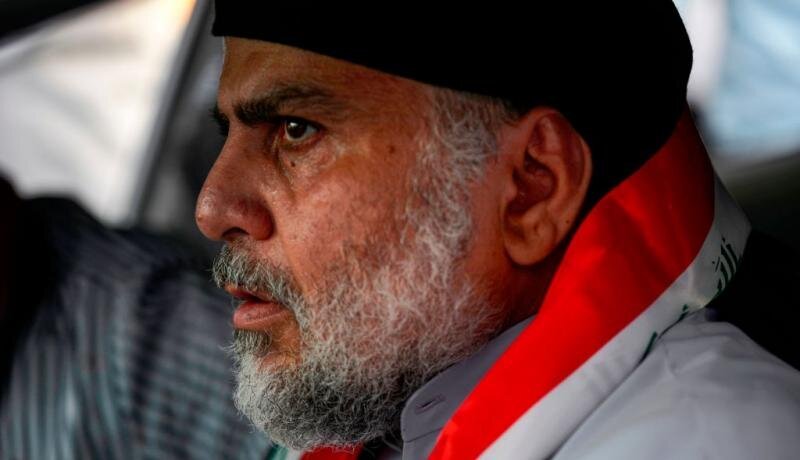Muqtada al-Sadr in Najaf, Iraq in October, 2019 (Credit: Getty Images)
Prominent Iraqi Shi’a cleric Muqtada al-Sadr was pressured to disband his “Blue Hat” guard corps on Tuesday in one of the most stunning turn of events since the beginning of the lraqi protest movement last October. Previously deployed to shield demonstrators against draconian crackdowns led by Iranian-sponsored militias, the Blue Hats had recently turned against the same protesters they were originally commissioned to protect.
The violence culminated last Wednesday evening, 6 February, when a contingent of Blue Hats attacked an encampment of demonstrators in the southern Iraqi city of Najaf, setting their tents ablaze and firing on them, killing 11. Condemnation against the brutality of Sadr’s militia swelled the ranks of protesters the following day across country, forcing the fiery cleric to publicly declare that he had dissolved the force less than a week later.
The rise and fall of the Blue Hats is just the latest chapter in the strange and tragic saga of the Iraqi street protest movement. Led mostly by Shi’a youth in the nation’s south, the protests broke out spontaneously on October 1 of last year. Fueled by growing discontent with government corruption, lack of employment and basic services, demonstrators were openly critical of Iranian influence in Iraqi politics. Iran, also embroiled in a brutal crackdown against its own street protest movement at home, sent elements of their Revolutionary Guard Corps (IRGC) to advise the Iraqi government and the powerful Iraqi militias which it sponsors, such as Kataib Hezbollah and the Badr Brigades. The militias, which were originally organized in 2014 to counteract the expansion of ISIS, have since been integrated into the Iraqi army, with many Iranian-linked militia leaders holding powerful positions in the military hierarchy.
Despite long-standing ties with Iranian clerics that predate the 2003 Iraq War, Muqtada al-Sadr initially styled himself as an Iraqi nationalist in support of the street protests, putting him at odds with his Iranian benefactors. He decried all foreign influences, including Iran, but especially the US-led Coalition. He hoped to ride the wave of grassroots anger and steer it against Western intervention in Iraq.
However, the death of Iranian Quds Force commander Qassem Soleimani and Kataib Hezbollah leader Abu Mahdi al-Mandis on 3 January was a turning point for the Iraqi cleric. After the death of their master strategist and faced with a growing protest movement that would not be stamped out by violent tactics, the Iranians were forced to reconsider their strategy in Iraq. They began wooing al-Sadr back into their fold in mid-January.
By the end of last month, al-Sadr had reconciled with the Iranian government and formed a parliamentary bloc with pro-Iranian Shi’a parties to appoint Mohammad Allawi as the new Iraqi prime minister. Allawi, who has close ties with Iran, was immediately rejected by the protest movement as a step backwards, putting the movement at odds with al-Sadr. Relations between the Sadrists and the demonstrators broke down quickly, with Sadr’s militiamen taking over the “Turkish Restaurant” in Baghdad’s Tahrir Square on 2 February, recognized as the hub of the protest movement. The massacre in Najaf came just a few days later.
Despite his pivot back towards Iran, al-Sadr continues to thread the needle. His office demanded Tuesday that the newly-appointed prime minister form a government and present it to the Iraqi parliament by 2 March or “face hell.” Muqtada continues to speak out in public support of demonstrators who are still taking to the streets daily across Iraq, while at the same time he is facilitating a political agenda that runs contrary to their demands. But political hedging and opportunism are nothing new for al-Sadr, who has a long history of chameleon tactics that stretch back to the early years of the Iraq War. During those years, he acted the firebrand by opposing US presence in Iraq and facilitating deadly, Iranian-orchestrated attacks on US forces while also portraying himself as a statesman and a unifying figure in Iraqi society. Now, with Iraq more divided than ever, al-Sadr’s political clout in Baghdad is the strongest it has ever been.
Sources:
https://www.chathamhouse.org/expert/comment/after-latest-turn-muqtada-al-sadr-losing-influence-iraq#
https://www.mideastcenter.org/post/from-badr-to-sadr-iraq-s-crucial-moment-january-27-to-february-7
https://www.middleeasteye.net/news/supporters-muqtada-al-sadr-accused-massacre-najaf
https://www.arabnews.com/node/1626301/middle-east
https://twitter.com/MidEast_Center/status/1223978046966894596
https://twitter.com/BaxtiyarGoran/status/1222175970418987014





